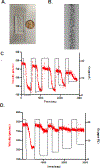Microfluidic methods to advance mechanistic understanding and translational research in sickle cell disease
- PMID: 35354090
- PMCID: PMC9218997
- DOI: 10.1016/j.trsl.2022.03.010
Microfluidic methods to advance mechanistic understanding and translational research in sickle cell disease
Abstract
Sickle cell disease (SCD) is caused by a single point mutation in the β-globin gene of hemoglobin, which produces an altered sickle hemoglobin (HbS). The ability of HbS to polymerize under deoxygenated conditions gives rise to chronic hemolysis, oxidative stress, inflammation, and vaso-occlusion. Herein, we review recent findings using microfluidic technologies that have elucidated mechanisms of oxygen-dependent and -independent induction of HbS polymerization and how these mechanisms elicit the biophysical and inflammatory consequences in SCD pathophysiology. We also discuss how validation and use of microfluidics in SCD provides the opportunity to advance development of numerous therapeutic strategies, including curative gene therapies.
Copyright © 2022 Elsevier Inc. All rights reserved.
Figures




References
-
- Rees DC, Gibson JS. Biomarkers in sickle cell disease. Br J Haematol 2012;156(4):433–445. - PubMed
-
- Kauf TL, Coates TD, Huazhi L, Mody-Patel N, Hartzema AG. The cost of health care for children and adults with sickle cell disease. Am J Hematol 2009;84(6):323–327. - PubMed
-
- National Center on Birth Defects and Developmental Disabilities CfDCaP Center For Disease Control. Vol. 2020. https://www.cdc.gov/ncbddd/sicklecell/data.html:CDC.gov; 2019.
Publication types
MeSH terms
Substances
Grants and funding
LinkOut - more resources
Full Text Sources
Medical

